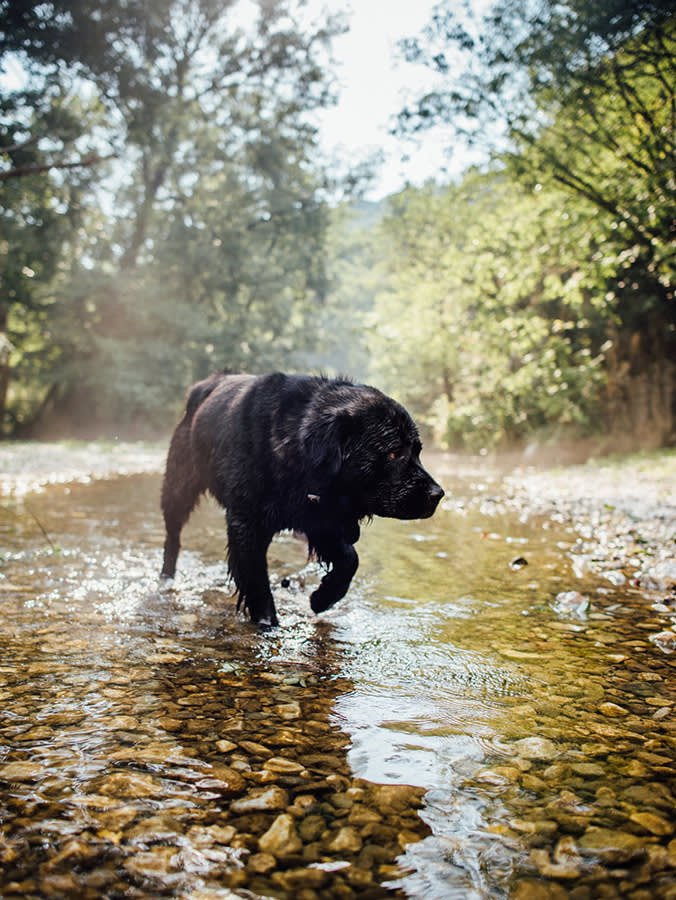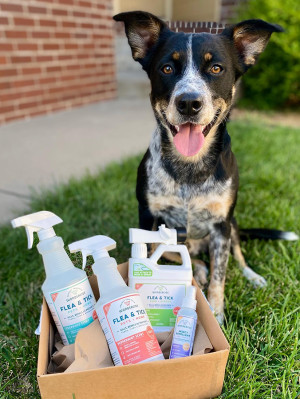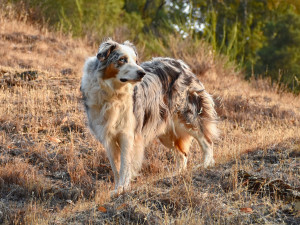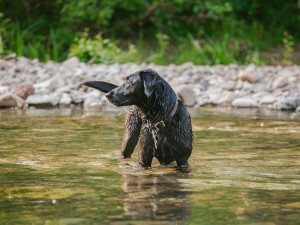Why Dog Parents Should Be Aware of Flesh-Eating Bacteria Right Now
It doesn’t just affect humans. Thankfully, this kind of wound infection is uncommon, but here’s what to look out for.

share article

Your pet wants you to read our newsletter. (Then give them a treat.)
Last week, the Centers for Disease Control issued warnings opens in a new tabfor deadly, rapidly progressive infections, which can thrive in warm, coastal areas. In addition, these infections in dogs have made headlinesin Floridaopens in a new tab and just outsideVancouver, B.C.opens in a new tab This infection, called necrotizing fasciitis, is a scary-sounding disease, but its common name evokes even more fear: “flesh-eating disease.” These reported cases have prompted pet parents to worry about how they can protect their dogs from this uncommon but dangerous condition.
What is flesh-eating disease in dogs?
Necrotizing fasciitisopens in a new tab is a bacterial infection of the tissues beneath the skin. This aggressive condition is rare in the grand scheme of wound infections, but it is particularly dangerous because of its rapid progression. Flesh-eating disease most commonly invades the fat and connective tissue (fascia) on the lower limbs, neck, or belly of dogs. Necrotizing fasciitis is difficult to diagnose in its early stages and can easily be mistaken for an ordinary wound infection before large lesions begin to develop.
The initial signs of flesh-eating disease share symptoms with most localized infections or opens in a new tab: regional pain, swelling, and redness. Early indicators of necrotizing fasciitis include rapidly spreading inflammation or a degree of pain that is out of line with the size of the wound. The severity of the condition becomes more obvious when a wide area of skin turns purplish or blackish and the dog becomes visibly ill.
A veterinarian will make a definitive diagnosis with tissue biopsies and bacterial cultures taken from deep within the infected area, but those tests take days to return. Dogs with this condition often decline before the diagnosis is confirmed. Imaging the area with radiographs or ultrasound may indicate that the infection is serious, but these tests are not definitive. Usually, a vet makes a tentative diagnosis based on the appearance of the wound and how quickly it is progressing.
How do dogs get flesh-eating disease?
Dogs most commonly develop necrotizing fasciitis after a skin wound of any type gets infected. Bacteria invade the wound and trigger an immune response, causing inflammation. These bacteria release toxins that restrict blood flow to the area of the infection. Without a good blood supply, the tissues begin to die off, and the infection spreads more easily.
The most commonly isolated bacterial species in these infections is β-hemolytic Streptococcus canis. Other bacteria that can cause necrotizing fasciitis include Escherichia coli, Staphylococcus spp., and Pseudomonas aeruginosa. These bacteria are part of a dog’s normal microbiomeopens in a new tab, so there’s no way to pre-treat and get rid of all the bacteria that cause flesh-eating disease. Fortunately, they never cause a serious problem in most dogs.
A study in 1999 found that the bacteria causing different cases of necrotizing fasciitis werenot closely relatedopens in a new tab, meaning that there was not a particular strain of dangerous bacteria being spread among dogs. It is more likely that a combination of factors related to an individual dog’s wound, bacterial population, and immune response results in this uncommon disease. This means that it’s very unlikely that this infection is contagious to other dogs or to your familyopens in a new tab.
What can be done to prevent flesh-eating disease in dogs?
There’s no surefire preventative because this disease is so unpredictable and is caused by the bacteria normally found on dogs’ skin. The best way to prevent severe illness is to be proactive about watching for wounds on your dog.
Observant pet parents should regularly check their dogs for scratches and scrapes, especially after they play in the water or wooded areas. A vet should evaluate an open wound as soon as possible. Watch any superficial wounds to make sure they heal normally. Any wound that is acting abnormally — causing a lot of pain, getting very swollen or red, or turning dark colors — is a cause for concern.
Where do dogs get flesh-eating disease from?
The scary thing about this aggressive disease is that it’s so unpredictable. Dogs who participate in more vigorous activities have more chances to get a wound that becomes infected. Things like running through densely wooded areas, playing rough with other dogs, hunting, or swimming in areas with rocky or uneven shores can increase the likelihood of scrapes and lacerations. Avoid risky activities when out with your dog to keep them as safe as possible from this condition.
How is flesh-eating disease treated in dogs?
Necrotizing fasciitis can be deadly. To give a dog a chance of surviving, it’s key to immediately recognize and treat the infection. Treatment with antibiotics helps to keep systemic infection under control. Unfortunately, antibiotics do not help much with the problem area because the body cannot deliver them to dead tissue. Surgery is needed to remove necrotic, infected tissue.
In cases where a limb is the source of the infection, your vet would recommend amputation to stop the infection before it spreads further. This is a tough decision for vets and pet parents, especially because it often needs to be made before the diagnosis is known with certainty. For wounds in other areas, long-term bandaging will be needed after the dead tissue has been removed.
Dogs with necrotizing fasciitis often have spread of bacteria throughout their bloodstream and body (sepsis) and become very sick from this. Aggressive in-hospital therapy is needed to provide appropriate care, including blood pressure support, pain control, and other therapies that can help with healing and overall comfort.
Getting wounds treated promptly and making sure they respond appropriately to treatment is the key to early recognition of flesh-eating disease. Necrotizing fasciitis is treatable, but delaying therapy creates an increased risk for life-threatening complications. Learning the symptoms and acting quickly are key to protecting your dog.
References

Dr. Bartley Harrison, DVM
Dr. Bartley Harrison, DVM is a small animal veterinarian based in North Carolina who has practiced emergency medicine since graduating from the Texas A&M College of Veterinary Medicine. His primary interest areas include pain management, cardiology, and the treatment of shock.
He is a member of the Veterinary Emergency and Critical Care Society, American Veterinary Medical Association, and American Medical Writers Association. In addition to his clinical work, he writes pet health articles to help provide accurate information for both new and experienced pet parents. When he’s not working, he enjoys cooking, traveling, reading, and going on adventures with his dog.
Related articles
![Australian Shepherd on a hill during golden hour]() opens in a new tab
opens in a new tabHow To Hike With Your Dog
How to get your gear — and your pup — ready to go.
![A woman walking with her dog in a garden.]() opens in a new tab
opens in a new tabHow to Take Your Dog On a Mindful Nature Walk
Wellness experts and animal trainers agree: a tuned-in spring outing can be restorative for both people and pets.
![Black Lab playing in creek]() opens in a new tab
opens in a new tabStay Far, Far Away From Blue-Green Algae This Summer
This stuff is already popping up across the U.S., and it’s super dangerous for your dog.
![Black dog swimming in a lake with people standing on a pier in the background and forest and mountains in the far distance]() opens in a new tab
opens in a new tabHow to Turn Your Dog Into a Swim Fan
Get them to master the doggy paddle with these trainer-approved tips.
![Bearded Collie running in a lake]() opens in a new tab
opens in a new tabWhen Drinking Too Much Water Is Deadly
How to keep your swim fan safe.








